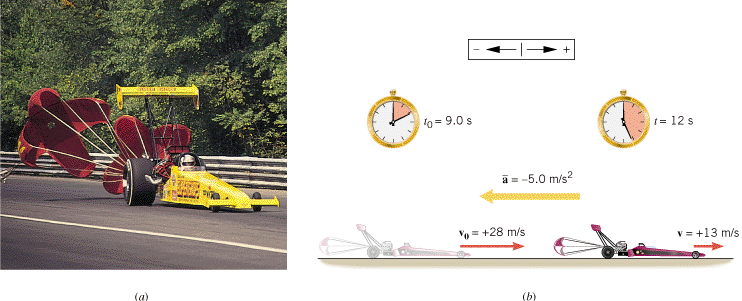|
A drag racer crosses the finish line, and the driver deploys a parachute and applies the brakes to slow down, as Figure 2.8 illustrates. The driver begins slowing down when t0 = = 9.0 s and the car’s velocity is v0 9.0 s and the car’s velocity is v0 = = +28 m/s. When t +28 m/s. When t = = 12.0 s, the velocity has been reduced to v 12.0 s, the velocity has been reduced to v = = +13 m/s. What is the average acceleration of the dragster? +13 m/s. What is the average acceleration of the dragster?
| Figure 2.8
(a) To slow down, a drag racer deploys a parachute and applies the brakes. (b) The velocity of the car is decreasing, giving rise to an average acceleration  that points opposite to the velocity. (© Geoff Stunkard) that points opposite to the velocity. (© Geoff Stunkard) |
|
Reasoning
The average acceleration of an object is always specified as its change in velocity, v – – v0, divided by the elapsed time, t v0, divided by the elapsed time, t – – t0. This is true whether the final velocity is less than the initial velocity or greater than the initial velocity. t0. This is true whether the final velocity is less than the initial velocity or greater than the initial velocity.
Solution
The average acceleration is, according to Equation 2.4,
|
![]() =
=![]() 9.0 s and the car’s velocity is v0
9.0 s and the car’s velocity is v0![]() =
=![]() +28 m/s. When t
+28 m/s. When t![]() =
=![]() 12.0 s, the velocity has been reduced to v
12.0 s, the velocity has been reduced to v![]() =
=![]() +13 m/s. What is the average acceleration of the dragster?
+13 m/s. What is the average acceleration of the dragster?![]() –
–![]() v0, divided by the elapsed time, t
v0, divided by the elapsed time, t![]() –
–![]() t0. This is true whether the final velocity is less than the initial velocity or greater than the initial velocity.
t0. This is true whether the final velocity is less than the initial velocity or greater than the initial velocity.


 that points opposite to the velocity. (© Geoff Stunkard)
that points opposite to the velocity. (© Geoff Stunkard)